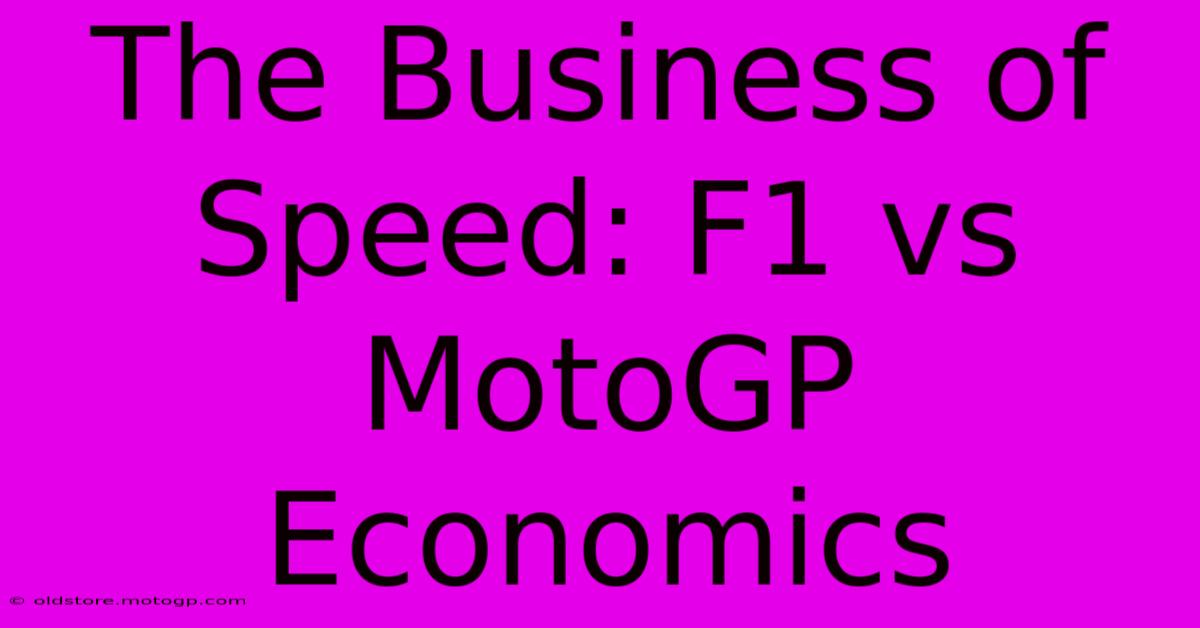The Business Of Speed: F1 Vs MotoGP Economics

Table of Contents
The Business of Speed: F1 vs MotoGP Economics
The roar of the engines, the breathtaking speeds, the nail-biting finishes – Formula 1 (F1) and MotoGP, the pinnacle of motorsport, captivate millions worldwide. But beyond the glamour and the thrill of the race lies a complex world of economics, sponsorship deals, and global branding. This article delves into the fascinating comparison of the financial landscapes of these two motorsport giants.
F1: The Heavyweight Champion of Motorsport Economics
F1 operates on a significantly larger scale than MotoGP. Its global reach, coupled with its long-standing history and iconic brand recognition, translates into a massive revenue stream.
Key Revenue Streams:
- Race Hosting Fees: Each Grand Prix host country pays substantial fees to secure the right to host a race. These fees contribute significantly to F1's overall revenue.
- Television Rights: F1 boasts lucrative television deals worldwide, generating billions in revenue annually. The broadcasting rights are a major source of income.
- Sponsorship: Major global brands vie for the opportunity to sponsor F1 teams and events. These sponsorships provide substantial funding for teams and the sport as a whole. Think of the impact of brands like Petronas, Aramco and others.
- Merchandising: F1 merchandise, from clothing and caps to model cars and collectibles, generates considerable revenue. This adds to the overall profit margin.
High Costs, High Rewards:
The immense revenue generated in F1 is matched by equally high costs. Running an F1 team requires a substantial investment in:
- Car Development: The sophisticated technology and engineering involved in designing and building F1 cars are exceptionally expensive. Constant research and development are crucial to staying competitive.
- Team Personnel: F1 teams employ hundreds of highly skilled engineers, mechanics, and support staff, incurring significant salary expenses. These are top-tier specialists in their fields.
- Travel and Logistics: Transporting the cars, equipment, and personnel to races around the globe is a costly undertaking. This requires significant logistical planning and expense.
MotoGP: A Nimble Contender in the Motorsport Market
MotoGP, while immensely popular, operates on a comparatively smaller scale than F1. However, its passionate fanbase and global appeal still generate substantial revenue.
Key Revenue Streams:
- Television Rights: Similar to F1, MotoGP benefits from lucrative television deals, albeit on a smaller scale. These deals provide critical revenue for the sport's operations.
- Sponsorship: Major motorcycle manufacturers and other brands sponsor teams and events, contributing to the sport's financial stability. These sponsorships are critical to funding teams and maintaining competitiveness.
- Merchandising: MotoGP merchandise, including apparel, model bikes, and other related items, contributes to the overall revenue stream. This allows fans to connect with their favorite riders and teams.
More Manageable Costs:
While MotoGP teams still face significant costs, they are generally lower than those in F1. The cost differences arise primarily from:
- Lower Car Development Costs: While MotoGP bikes are technologically advanced, their development costs are lower than those of F1 cars. The emphasis on rider skill is a factor in this cost difference.
- Smaller Team Sizes: MotoGP teams are generally smaller than their F1 counterparts, leading to lower salary expenses and operational overhead. This streamline results in more manageable costs.
- Less Extensive Travel Logistics: While still globally-based, MotoGP's logistical challenges are comparatively less complex than those faced by F1. This contributes to overall cost reduction.
The Bottom Line: A Tale of Two Titans
Both F1 and MotoGP are economically successful motorsport series, attracting global attention and generating significant revenue. However, F1 operates on a significantly larger scale, with higher revenues and correspondingly higher costs. MotoGP offers a more streamlined and potentially more manageable economic model, albeit with a smaller overall revenue pool. The success of each series demonstrates the enduring power of motorsport to captivate fans and attract substantial commercial investment. The future of both will depend on adapting to the changing economic landscape, maintaining fan engagement, and securing lucrative partnerships to remain competitive.

Thank you for visiting our website wich cover about The Business Of Speed: F1 Vs MotoGP Economics. We hope the information provided has been useful to you. Feel free to contact us if you have any questions or need further assistance. See you next time and dont miss to bookmark.
Featured Posts
-
The Thrill Of The Chase Moto Gp Sprint Highlights
Feb 18, 2025
-
F1 Austin 2025 What To Expect
Feb 18, 2025
-
Cota Lot R The Insiders Guide To Parking
Feb 18, 2025
-
Unleash The Beast Cota Track Day
Feb 18, 2025
-
Motorbike Racing The Ultimate Adrenaline Rush
Feb 18, 2025
